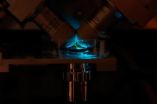(Press-News.org) Researchers can now watch molecules move in living cells, literally millisecond by millisecond, thanks to a new microscope developed by scientists at the European Molecular Biology Laboratory (EMBL) in Heidelberg, Germany. Published online today in Nature Biotechnology, the new technique provides insights into processes that were so far invisible.
By combining light-sheet microscopy and single molecule spectroscopy, the new microscope can record the fluorescence of every pixel within view, and take snapshots at intervals of less than one millisecond. With it, scientists can watch and measure very fast processes, such as the way molecules diffuse, across a whole sample, even one containing several cells. This is a considerable step up from previous techniques, based on confocal microscopy, in which researchers could only observe at most a few isolated spots in a sample at a time.
"It's really visual biochemistry," says Malte Wachsmuth, who developed the microscope at EMBL. "We can follow fluorescently-tagged molecules in whole live cells, in 3D, and see how their biochemical properties, like interaction rates and binding affinities, vary throughout the cell."
Until now, chromatin – the combination of DNA, RNA and proteins that forms chromosomes – had been observed in two states: wound tightly together, with most of its DNA inaccessible to the cell's gene-reading machinery, in which case it is called heterochromatin; or loosely packed and easily readable, called euchromatin. But when they used the new microscope to measure the interaction between chromatin and a protein called HP1-α, the EMBL scientists made an intriguing discovery.
"In some areas that look like euchromatin, HP1-α behaves as it would in the presence of heterochromatin," says Michael Knop, now at the University of Heidelberg, Germany. "This suggests that chromatin may also exist in an intermediate state between hetero- and euchromatin, which was not observable before in living cells."
By providing a tool to watch molecules that move very fast, the scientists believe this new microscope will help to investigate processes ranging from the role of growth hormones in cancer to the regulation of cell division and signalling and the patterning of tissue development in the embryo.
INFORMATION:
Live from the scene: Biochemistry in action
New microscope follows single molecules by the millisecond
2011-08-09
ELSE PRESS RELEASES FROM THIS DATE:
'Paranoia' about rivals alters insect mating behavior
2011-08-09
Scientists at the University of Liverpool have found that male fruitflies experience a type of 'paranoia' in the presence of another male, which doubles the length of time they mate with a female, despite the female of the species only ever mating with one male.
Females in many species of animal have multiple mates and males have evolved particular reproductive characteristics to ensure their sperm are successful when in competition with the sperm of other males. Adaptations include physical traits that result in increased sperm count, as well as behavioural alterations ...
Schoolchildren can also learn complex subject matters on their own
2011-08-09
Calculating the surface area of Gran Canaria is no easy task for a 14-year-old. It's not simply a question of learning the right formula. Students have to develop a strategy that enables them to put mathematical theory into practice – working out the information that is important and applying the right geometric models and tools. Realizing that the island has an almost circular shape and so its surface area can be approximated using the area of a circle is not as straightforward as it sounds. Are schoolchildren capable of developing these kinds of solutions themselves or ...
Light unlocks fragrance in laboratory
2011-08-09
In Anna Gudmundsdottir's laboratory at the University of Cincinnati, dedicated researchers endeavor to tame the extremely reactive chemicals known as radicals.
Highly reactive radicals are atoms, molecules or ions frantically trying to become something else. Their lifetimes are measured in fractions of seconds and typically occur in the middle of a chain of chemical reactions. They are also known as reactive intermediates. Much of Gudmundsdottir's work has focused on a family of radicals known as triplet nitrenes.
"Triplet nitrenes are reactive intermediates with high ...
Walking around is the simplest way to shorten hospital stay
2011-08-09
A new study from the University of Haifa has found that walking around the ward during hospitalization significantly reduces the length of the older patient's stay. "Given the over-occupancy of many hospitals, this finding can be of great importance," the researchers stated.
Walking around the ward during hospitalization reduces the length of geriatric patients' stay in internal wards. This has been shown in a new study by Dr. Efrat Shadmi and Dr. Anna Zisberg of the University of Haifa's Department of Nursing, funded by the Israeli Science Foundation and published in ...
Many top US scientists wish they had more children
2011-08-09
Nearly half of all women scientists and one-quarter of male scientists at the nation's top research universities said their career has kept them from having as many children as they had wanted, according to a new study by Rice University and Southern Methodist University (SMU).
The study, "Scientists Want More Children," was authored by sociologists Elaine Howard Ecklund of Rice and Anne Lincoln of SMU and appears in the current issue of the journal PLoS ONE.
For the past three years, Ecklund and Lincoln have been studying what junior and senior scientists in physics, ...
Technology reveals citrus greening-infected trees
2011-08-09
U.S. Department of Agriculture (USDA) scientists are using a technology known as "Fourier transform infrared-attenuated total reflection" (FTIR-ATR) spectroscopy to rapidly identify with 95 percent accuracy citrus plant leaves infected with the devastating disease known as citrus greening.
Scientists from the Agricultural Research Service (ARS) Subtropical Plant Pathology Research Unit in Fort Pierce, Fla., and the agency's Quality and Safety Assessment Research Unit in Athens, Ga., collaborated on the use of FTIR-ATR spectroscopy to identify citrus greening in plants. ...
Most Canadians can be uniquely identified from their date of birth and postal code
2011-08-09
OTTAWA – August 8, 2011 – There are increasing pressures for health care providers to make individual-level data readily available for research and policy making. But Canadians are more likely to allow the sharing of their personal data if they believe that their privacy is protected. A new report by Dr. Khaled El Emam, the Canada Research Chair in Electronic Health Information at the University of Ottawa and the Children's Hospital of Eastern Ontario Research Institute, suggests that Canadians can be uniquely identified from their date of birth, postal code, and gender. ...
Flowing structures in soft crystals
2011-08-09
A liquid does not have to be a disordered bunch of particles: A team of researchers at Vienna University of Technology (TU Vienna) and the University of Vienna has discovered intriguing structures formed by tiny particles floating in liquids. Under mechanical strain, particle clusters in liquids can spontaneously form strings and dramatically alter the properties of the liquid.
What is common to blood, ink and gruel? They are all liquids in which tiny particles are suspended – so called "colloids". In some of these liquids, the particles form groups (clusters), which ...
Some hospitals better than others in selecting patients to undergo cardiac catheterization
2011-08-09
Hospitals vary markedly when it comes to the rate at which diagnostic coronary angiography or catheterization – an invasive procedure that allows doctors to see the vessels and arteries leading to the heart – actually finds obstructive coronary artery disease (CAD) in people without known heart disease.
In fact, while some U.S. hospitals report that 100 percent of patients undergoing this procedure were found to have CAD, others had rates as low as 23 percent, meaning the majority of patients selected for elective catheterization did not have blockages, according to ...
Cancer biomarker -- detectable by blood test -- could improve prostate cancer detection
2011-08-09
CINCINNATI—A new study supports the use of a DNA-based "biomarker" blood test as a complement to the prostate-specific antigen (PSA) test currently offered to screen men for prostate cancer. University of Cincinnati (UC) researchers report their findings online ahead of print in the British Journal of Cancer.
Researchers conducted a meta-analysis of existing published data related to DNA methylation in bodily fluids. The goal was to evaluate a specific cancer biomarker—known as GSTP1—as a screening tool for prostate cancer.
The study was a cross-disciplinary collaborative ...
LAST 30 PRESS RELEASES:
Manta rays create mobile ecosystems, study finds
Study: Mixed results in using lipoic acid to treat progressive multiple sclerosis
Norbert Holtkamp appointed director of Fermi National Accelerator Laboratory
New agentic AI platform accelerates advanced optics design
Biologists discover neurons use physical signals — not electricity — to stabilize communication
Researchers discover that a hormone can access the brain by hitchhiking
University of Oklahoma researcher awarded funding to pursue AI-powered material design
Exploring how the visual system recovers following injury
Support for parents with infants at pediatric check-ups leads to better reading and math skills in elementary school
Kids’ behavioral health is a growing share of family health costs
Day & night: Cancer disrupts the brain’s natural rhythm
COVID-19 vaccination significantly reduces risk to pregnant women and baby
The role of vaccination in maternal and perinatal outcomes associated with COVID-19 in pregnancy
Mayo Clinic smartwatch system helps parents shorten and defuse children's severe tantrums early
Behavioral health spending spikes to 40% of all children’s health expenditures, nearly doubling in a decade
Digital cognitive behavioral treatment for generalized anxiety disorder
Expenditures for pediatric behavioral health care over time and estimated family financial burden
Air conditioning in nursing homes and mortality during extreme heat
The Alps to lose a record number of glaciers in the next decade
What makes a good proton conductor?
New science reporting guide published for journalists in Bulgaria
New international study reveals major survival gaps among children with cancer
New science reporting guide published for journalists in Turkey
Scientists develop a smarter mRNA therapy that knows which cells to target
Neuroanatomy-informed brain–machine hybrid intelligence for robust acoustic target detection
Eight SwRI hydrogen projects funded by ENERGYWERX
The Lundquist Institute and its start-up company Vitalex Biosciences Announces Strategic Advancement of Second-Generation fungal Vaccine VXV-01 through Phase 1 Trials under $40 Million Competitive Con
Fine particles in pollution are associated with early signs of autoimmune disease
Review article | Towards a Global Ground-Based Earth Observatory (GGBEO): Leveraging existing systems and networks
Penn and UMich create world’s smallest programmable, autonomous robots
[Press-News.org] Live from the scene: Biochemistry in actionNew microscope follows single molecules by the millisecond

